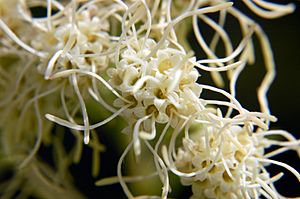False boneset facts for kids
Brickellia eupatorioides is a fascinating plant often called false boneset. It's part of the huge daisy family, which includes many common flowers like sunflowers and dandelions. This plant is native to North America, meaning it naturally grows there. You can find it widely spread across Mexico and most parts of the contiguous United States, except for the very northeastern states and the West Coast.
Quick facts for kids False boneset |
|
|---|---|
 |
|
| var corymbulosa | |
| Scientific classification | |
| Kingdom: | |
| (unranked): | |
| (unranked): | |
| (unranked): | |
| Order: | |
| Family: | |
| Subfamily: |
Asteroideae
|
| Tribe: |
Eupatorieae
|
| Genus: |
Brickellia
|
| Species: |
B. eupatorioides
|
| Binomial name | |
| Brickellia eupatorioides (L.) Shinners
|
|
| Synonyms | |
|
Synonymy
Brickellia rosmarinifolia (Vent.) W.A.Weber
Critonia kuhnia Gaertn. Eupatorium alternifolium Ard. Eupatorium kuhnia Crantz Kuhnia altaica Raf. Kuhnia cinerea Raf. Kuhnia critonia Willd. Kuhnia dasypia Raf. Kuhnia divaricata Raf. Kuhnia elliptica Raf. Kuhnia eupatorioides L. Kuhnia fitzpatrickii Nelson Kuhnia fulva Raf. Kuhnia glabra Raf. Kuhnia glomerata Raf. Kuhnia glutinosa Elliott Kuhnia gooddingii Nelson Kuhnia jacobaea Lunell Kuhnia latifolia Raf. Kuhnia macrantha Buckley Kuhnia maximiliani Sinning Kuhnia media Raf. Kuhnia paniculata Cass. Kuhnia pubescens Raf. Kuhnia reticulata Nelson Kuhnia suaveolens Fresen. Kuhnia tuberosa Raf. Kuhnia virgata Raf. Brickellia chlorolepis (Wooton & Standl.) Shinners, syn of var. chlorolepis Kuhnia microphylla Shinners, syn of var. chlorolepis Brickellia schaffneri (A.Gray) Shinners, syn of var. chlorolepis Kuhnia chlorolepis Wooton & Standl., syn of var. chlorolepis Kuhnia hitchcocki Nelson, syn of var. corymbulosa Kuhnia hitchcockii Nelson, syn of var. corymbulosa Brickellia mosieri (Small) Shinners, syn of var. floridana |
|
Contents
What is Brickellia eupatorioides?
Brickellia eupatorioides is a type of plant that lives for many years. It can grow quite tall, sometimes reaching up to 200 centimeters (about 80 inches). It starts growing from a strong, woody base.
Its Flowers
This plant produces many small flower heads. These flower heads are special because they look like one big flower but are actually made of many tiny flowers grouped together. The flowers can be yellow, lavender, or even maroon. They have disc florets, which are the small, tube-shaped flowers in the center of a daisy. However, they do not have ray florets, which are the petal-like flowers you see on the outside of a daisy.
Where Does It Grow?
This plant is very common across a large area. In Mexico, you can find it from the state of Chihuahua all the way down to Oaxaca. In the United States, it grows in almost every state, except for the states in New England, New York, and along the West Coast. This wide range shows that it can adapt to many different environments.
Varieties of Brickellia eupatorioides
Just like there are different breeds of dogs, there are different varieties of plants. These varieties are slightly different versions of the same species. They might have small differences in their leaves, flowers, or where they grow best. Here are some of the known varieties of Brickellia eupatorioides:
- Brickellia eupatorioides var. chlorolepis - Found in Mexico and the southwestern USA.
- Brickellia eupatorioides var. corymbulosa - Grows in the Great Plains and the Mississippi Valley.
- Brickellia eupatorioides var. eupatorioides - This is the main variety, found in the eastern USA.
- Brickellia eupatorioides var. floridana - Grows in southern Florida.
- Brickellia eupatorioides var. gracillima - Found in Arkansas, Missouri, Oklahoma, and Texas.
- Brickellia eupatorioides var. texana - Also found in Arkansas, Kansas, Missouri, Oklahoma, and Texas.
See also
 In Spanish: Brickellia eupatorioides para niños
In Spanish: Brickellia eupatorioides para niños

